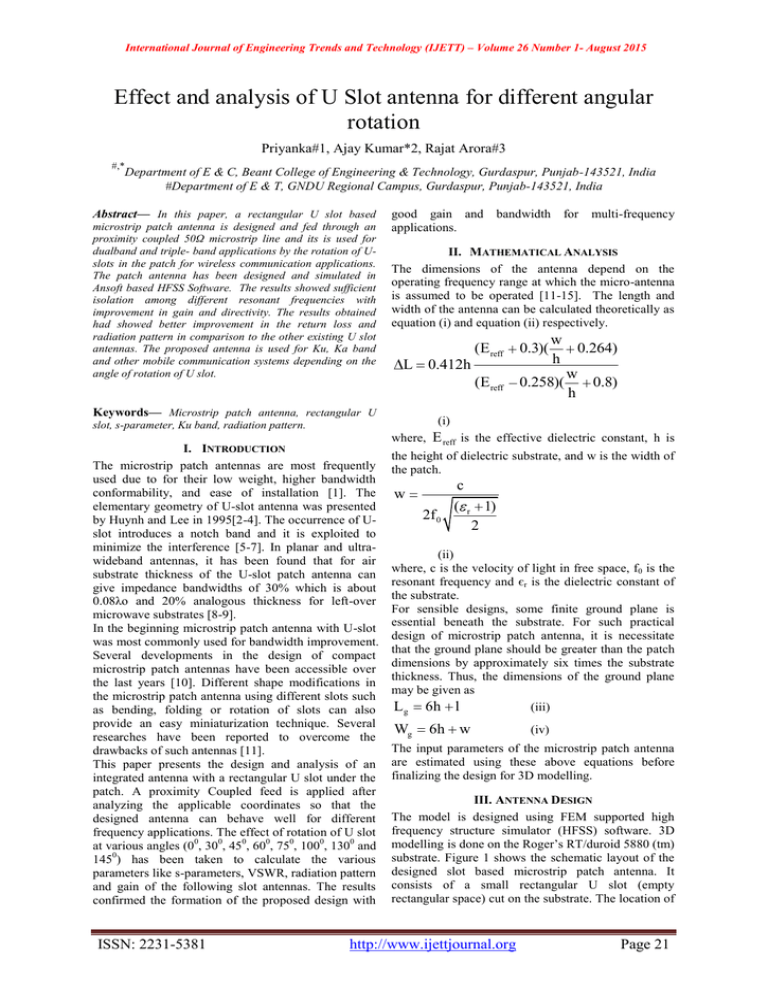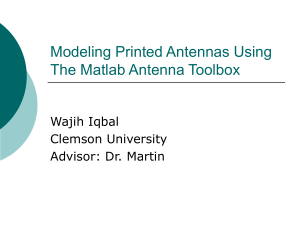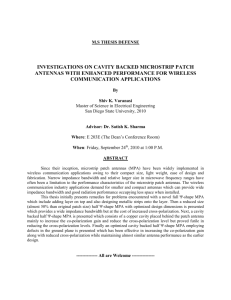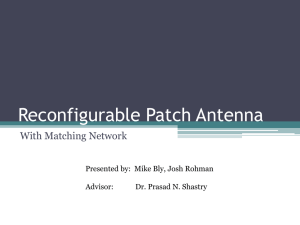Effect and analysis of U Slot antenna for different angular rotation
advertisement

International Journal of Engineering Trends and Technology (IJETT) – Volume 26 Number 1- August 2015 Effect and analysis of U Slot antenna for different angular rotation Priyanka#1, Ajay Kumar*2, Rajat Arora#3 #,* Department of E & C, Beant College of Engineering & Technology, Gurdaspur, Punjab-143521, India #Department of E & T, GNDU Regional Campus, Gurdaspur, Punjab-143521, India Abstract— In this paper, a rectangular U slot based microstrip patch antenna is designed and fed through an proximity coupled 50Ω microstrip line and its is used for dualband and triple- band applications by the rotation of Uslots in the patch for wireless communication applications. The patch antenna has been designed and simulated in Ansoft based HFSS Software. The results showed sufficient isolation among different resonant frequencies with improvement in gain and directivity. The results obtained had showed better improvement in the return loss and radiation pattern in comparison to the other existing U slot antennas. The proposed antenna is used for Ku, Ka band and other mobile communication systems depending on the angle of rotation of U slot. good gain and applications. (E reff L 0.412h (E reff w 0.264) h w 0.258)( 0.8) h 0.3)( (i) slot, s-parameter, Ku band, radiation pattern. ISSN: 2231-5381 multi-frequency II. MATHEMATICAL ANALYSIS The dimensions of the antenna depend on the operating frequency range at which the micro-antenna is assumed to be operated [11-15]. The length and width of the antenna can be calculated theoretically as equation (i) and equation (ii) respectively. Keywords— Microstrip patch antenna, rectangular U I. INTRODUCTION The microstrip patch antennas are most frequently used due to for their low weight, higher bandwidth conformability, and ease of installation [1]. The elementary geometry of U-slot antenna was presented by Huynh and Lee in 1995[2-4]. The occurrence of Uslot introduces a notch band and it is exploited to minimize the interference [5-7]. In planar and ultrawideband antennas, it has been found that for air substrate thickness of the U-slot patch antenna can give impedance bandwidths of 30% which is about 0.08λo and 20% analogous thickness for left-over microwave substrates [8-9]. In the beginning microstrip patch antenna with U-slot was most commonly used for bandwidth improvement. Several developments in the design of compact microstrip patch antennas have been accessible over the last years [10]. Different shape modifications in the microstrip patch antenna using different slots such as bending, folding or rotation of slots can also provide an easy miniaturization technique. Several researches have been reported to overcome the drawbacks of such antennas [11]. This paper presents the design and analysis of an integrated antenna with a rectangular U slot under the patch. A proximity Coupled feed is applied after analyzing the applicable coordinates so that the designed antenna can behave well for different frequency applications. The effect of rotation of U slot at various angles (00, 300, 450, 600, 750, 1000, 1300 and 1450) has been taken to calculate the various parameters like s-parameters, VSWR, radiation pattern and gain of the following slot antennas. The results confirmed the formation of the proposed design with bandwidth for where, E reff is the effective dielectric constant, h is the height of dielectric substrate, and w is the width of the patch. w 2f 0 c ( r 1) 2 (ii) where, c is the velocity of light in free space, f0 is the resonant frequency and єr is the dielectric constant of the substrate. For sensible designs, some finite ground plane is essential beneath the substrate. For such practical design of microstrip patch antenna, it is necessitate that the ground plane should be greater than the patch dimensions by approximately six times the substrate thickness. Thus, the dimensions of the ground plane may be given as L g 6h l (iii) Wg 6h w (iv) The input parameters of the microstrip patch antenna are estimated using these above equations before finalizing the design for 3D modelling. III. ANTENNA DESIGN The model is designed using FEM supported high frequency structure simulator (HFSS) software. 3D modelling is done on the Roger’s RT/duroid 5880 (tm) substrate. Figure 1 shows the schematic layout of the designed slot based microstrip patch antenna. It consists of a small rectangular U slot (empty rectangular space) cut on the substrate. The location of http://www.ijettjournal.org Page 21 International Journal of Engineering Trends and Technology (IJETT) – Volume 26 Number 1- August 2015 the proximity feed point is set using theoretical analysis. A rectangular patch is installed above the slot. The substrate and a patch are separated with each other by a dielectric material (air). Though both are independent of each other, however, the output depends on the distance, position and the orientation of a U slot. IV. RESULT AND DISCUSSION The results verify the alteration in frequency bands and bandwidth with respect to change in position of the feed point. For this design simulation, the processing speed of the computational machine is 3.4 GHz with 4 GB RAM. The virtual memory used while simulation is 2.1 GHz. Precise sized meshing is not selected to avoid the computational load. Frequency domain setting is selected for simulating the model. The characteristic impedance (Z0) of the simulated design comes out to be 30 Ω (approx). Theoretically, the value of Z0 is 50 Ω that shows small existence of standing waves while propagation of RF signals. Figure 2 shows the schematic of the antenna design. Fig.1 Layout of simulated U slot patch antenna The dimensions and the type of material used for designing the proposed micro-antenna are shown in Table 1. The antenna is enclosed in the rectangular (75 mm x 75 mm) shaped domain with thickness 1 mm. The domain contains air or vacuum inside it. The basis to enclose the micro-antenna in domain surrounded by a perfectly matched layer (PML) is to absorb the radiation from the antenna with minimum reflection so that it contains minimum return loss. Table 1: Materials and dimensions. Name Height Length Width Substrate 3.0 mm 50 mm 50 mm Ground -12.0 mm 50 mm 50 mm Patch 0.5 mm 20 mm 15 mm Feed Line 0.1 mm 40 mm 5mm Material Rogers RT/duriod 5880 (tm) Perfect electric conductor Perfect electric conductor Perfect electric conductor Table 2 shows the material properties selected for different parameters that are equally responsible for the successful design of an antenna. The material chosen for the ground and the patch are same. The frequency range selected for the proposed design is inbetween 15 GHz to 19 GHz that lies in the Ku, and Kband of the frequency spectrum. Table 2: Material properties. Parameters Permittivity (єr) Permeability (μr) Density (kg/m3) Rogers RT 5880 2.2 1.0 - Air in rectangular domain 1.0 1.0 1.16 A U slot is cut in such a way that it provides soft and smooth edges. The feed line is selected in such a way that the designed microstrip patch antenna may work successfully for the number of frequency regions. ISSN: 2231-5381 Fig.2 Schematic of the antenna design. The effect of rotation of U slot at various angles (00, 300, 450, 600, 750, 1000, 1300 and 1450) has been taken to calculate the various parameters like s-parameters, VSWR, and radiation pattern that are shown from fig. (a) to fig. (h) in sequential manner. Figure 3 shows the plot between return losses versus frequency with slot rotation at above said angles. The graph clearly shows different resonant frequencies at different rotation angles. Resonant frequencies are considered for the dips that lie beyond -10 dB. The high value of return loss means that the reflection wave return back to the source is very small and the amount of radiation power is very high. Thus, from this graph, it is verified that by rotating the U slot, the proposed antenna can operate in different frequency regions. Table 3 shows the angle of U slot with respect to feed line and their obtained resonant frequencies with bandwidth. Table 3: Slot rotation and their resonant frequencies Angle of Rotation for slot 00 300 450 600 750 1000 1300 1450 Resonant frequencies (GHz) Bandwidth (GHz) 18.8 16.5,18.25,19.25 15.87,17.3,18.7 17.4,18.9 16,17,18 16.62,18.10,18.75,19.35 15.9,17.35,18.8 17.7,18.7 0.27 0.25,0.22 0.17,0.22,0.3 0.5 0.15,0.3 0.2,0.45,0.1,0.32 0.3,0.25 0.2,0.17 http://www.ijettjournal.org Page 22 International Journal of Engineering Trends and Technology (IJETT) – Volume 26 Number 1- August 2015 Fig.3 Plot of an antenna showing return loss vs frequency The value of the resonant frequencies for these different frequency regions is confirmed by the far field radiation plots as is shown in figure 4. Showing the radiation patterns which is radiating in one direction. ISSN: 2231-5381 Similarly, figure 5 shows the Gain values for different U slot angles. The VSWR for the corresponding U slot rotation shows VSWR <2 at 1000 . http://www.ijettjournal.org Page 23 International Journal of Engineering Trends and Technology (IJETT) – Volume 26 Number 1- August 2015 Fig. 4 Radiation patterns for different slot angles. Fig.5 Graph showing Gain values at different rotational angles of slot. ISSN: 2231-5381 http://www.ijettjournal.org Page 24 International Journal of Engineering Trends and Technology (IJETT) – Volume 26 Number 1- August 2015 Fig. 6 Graph showing VSWR values at different rotational angles of slot. From these results, we estimate that the asdesigned microstrip patch antenna may work successfully for different frequency applications. The radiation pattern is also changing with respect to rotational angle of a slot. However, the gains of all the antennas are almost constant. The bandwidth of the operating frequency shows that the designed antenna may work well for the mobile communication. V. CONCLUSIONS In this work, a U slot patch antenna is simulated to evaluate the effect of rotation of a U slot with respect to feed line. A simple proximity couple feed line is convoluted to analyse the results. A simple and easy method is used to design the rectangular patch and a U slot is cut to devise the proposed structure. The results verified the formation of the proposed design for different wireless applications. Best results were obtained at slot angle=1000 at this angle, losses (return loss & tangent loss) are very low and VSWR<2.The estimated bandwidth at this angle is well enough to be operated successfully for mobile communication applications and the gain is 6.1234 dB respectively. [1] A. E. Daniel and G. Kumar, “Tuneable dual and triple frequency stub loaded rectangle microstrip antenna,” in Proc. IEEE Trans. Antennas Propagat.Symp., June 1995, pp. 2140–2143. [2] K. F. Lee, K. M. Luk, K. M. Mak, S. L. S. Yang, “On the use of U-slots in the design of dual-and triple-band patch antennas,” IEEE Antennas Propag. Mag., vol. 53, pp. 60– 74, 2011. [3] S. Arya, S. Khan, C. Shan, P. Lehana, “Design of Small Integrated Antenna for Peer to Peer Wireless Communication,” International Journal of Mobile Network Communications & Telematics (IJMNCT), vol. 2, no. 3, pp. 11-20, 2012. [4] Garima, Amanpreet Kaur, Rajesh Khanna, "Dual- and Triple- Band U-slot Microstrip Patch Antenna for WLAN Applications, "International Journal of Advanced Research in Computer and Communication Engineering Vol. 2, Issue 5, May 2013. REFERENCES ISSN: 2231-5381 http://www.ijettjournal.org Page 25 International Journal of Engineering Trends and Technology (IJETT) – Volume 26 Number 1- August 2015 [5] [6] [7] [8] [9] [10] [11] [12] [13] [14] [15] K. Buell, H. Mosallaei and K. Sarabandi, “A substrate for small patch antennas providing tunable miniaturization factor," IEEE Trans. Microwave Theory Tech., Vol. 54, 135-139, 2006. D. M. Pozar, Microwave Engineering: Wiley Inter-science, 2006. R. Chair, C. L. Mak, K. F. Lee, K. M. Luk, A. A. Kishk, “Miniature wide-band half U-slot and half E-shaped patch antennas,” IEEE Transactions on Antennas and Propagation., Vol. 53, pp. 2645–2652, 2005. J. Anguera, G. Font, C. Puente, C. Borja, J. Soler, “Multifrequency microstrip patch antenna using multiple stacked elements,” IEEE Microw. Wireless Compon. Lett., vol. 13, no. 3, pp. 123–124, 2003. A. Boag, Y. Shimony, A. Boag, and R. Mittra “Dual-Band Cavity Backed Quarter Wave Patch Antenna,” IEEE Intemational Symposium on Antennas and Propagation Digest, Newport Beach, Califomia, pp. 2124-2127, June 18-23, 1995,. K. F. Lee, S. L. S. Yang, and A. Kishk, “Dual- and multiband U-slot patch antennas,” IEEE Antennas Wireless Commun. Lett., Vol. 7, pp. 645–648, 2008. R. Arora, A. Kumar, S. Khan, S. Arya, “Finite Element Modelling and Design of Rectangular Patch Antenna with Different Feeding Techniques,” Open Journal of Antenna and Propagation, Vol. 1, No. 1, pp. 11-17, 2013. S. Arya, S. Khan, C. Shan, P. Lehana, “Design of a Microstrip Patch Antenna for Mobile Wireless Communication Systems,” Journal of Computational Intelligence and Electronic Systems, Vol. 1, No. 2, pp. 178182, 2012. R. Arora, A. Kumar, S. Khan, S. Arya, "Design Analysis and Comparison of HE and E Shaped Microstrip Patch Antennas," International Journal on Communications Antenna and Propagation, Vol. 4, No. 1, pp. 27-31, 2014. K. O. Odeyemi, D. O. Akande, and E. O. Ogunti, “Design of an S-Band Rectangular Microstrip Patch Antenna,” European Journal of Scientific Research, Vol. 55, No.1, pp.72-79, 2011. F. Yang, X. X. Zhang, X. Ye, and Y. Rahmat-Samii, “Wide-band E-shaped patch antennas for wireless communications,” IEEE Trans. Antennas Propagat., Vol. 49, pp. 1094–1100, July 2001. ISSN: 2231-5381 http://www.ijettjournal.org Page 26



![EEE 443 Antennas for Wireless Communications (3) [S]](http://s3.studylib.net/store/data/008888255_1-6e942a081653d05c33fa53deefb4441a-300x300.png)
